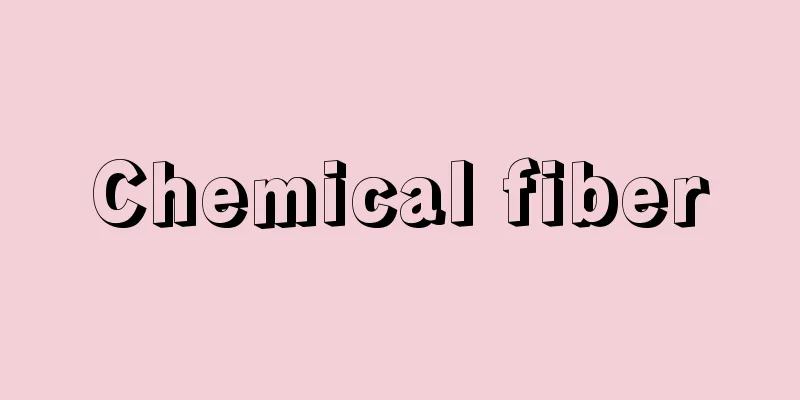Chemical fiber

|
In contrast to natural fibers, these are fibers that humans create using chemical means, and are also called man-made fibers. However, when used in the narrow sense, the term man-made fibers refers to chemical fibers excluding synthetic fibers. Regenerated fibers, which are man-made fibers in the narrow sense, are made by artificially modifying the natural polymeric substance cellulose, as well as animal and plant proteins, into fiber form. Examples include viscose rayon and staple fiber, cupra (trade name Bemberg in Japan) made using the cuprammonium process, and fibers made from milk casein and soybeans. Pure synthetic fibers are made by artificially synthesizing small molecular weight chemicals into polymeric substances large enough to form fibers, and many have been announced, but the most widely produced are nylon, aromatic nylon (aramid fiber), polyester fibers, acrylic fibers, and polyvinyl alcohol fibers (Vinylon). Semi-synthetic fibers are made by treating the natural polymeric substance cellulose with chemicals to create a chemical derivative of cellulose, and then spinning it into fiber, with acetate being a typical example. Inorganic fibers are combined with plastics to form so-called FRP (Fiber Reinforced Plastics). FRP is a tough plastic material that rivals metals, and glass fiber, carbon fiber, silicon carbide fiber, boron fiber, alumina fiber, and other materials have been researched and put to practical use, and their development is remarkable. [Hiroshi Kakiuchi] "The Chemical Fiber Industry Theory" by Ohara Soichiro (1961, University of Tokyo Press)" ▽ "Chemical Fibers, vols. 1-3 (1970, 1971, Maruzen) edited by H.F. Mark and S.M. Atlas, translated by Ishii Kinzo and Nukushina Kenji" (1970, 1971)" ▽ "History of the Japanese Chemical Fiber Industry" (1974) edited and published by the Japan Chemical Fibers Association" ▽ "Chemical Fibers - The Science of Polymers Challenging the Dreams of Mankind" by Yasuda Takeshi (1979, Kodansha)" ▽ "Textiles, 3rd edition edited by Onuma Ikuzo et al. (1986, Tokyo Denki University Press)" ▽ "Practical Knowledge of Chemical Fibers" edited by the Japan Chemical Fibers Association (1986, Toyo Keizai Shinposha)" ▽ "Organic Chemistry, 6th edition (1988, Asakura Shoten) edited by Akawa Toshio et al. " ▽ "Chemistry for One Billion People, 6th Edition" edited by the Chemical Society of Japan Fashion and Chemistry (1992, Dai Nippon Tosho) ▽ Bunka Publishing Bureau, editor and publisher, The Latest Clothing Materials: Chemical Fibers (1993) ▽ Sakurauchi Yujiro, Plastics Technology Reader, fully revised edition (1993, Industrial Research Institute) ▽ Ueno Kazuyoshi et al., The Story of Fibers -- From Natural Fibers to Functional Fibers (1998, Japanese Standards Association) ▽ Japan Chemical Fiber Promotion Association, editor and publisher, 50 Years of the Chemical Fiber Promotion Association (1999) ▽ Japan Chemical Fiber Promotion Association, editor and publisher, Chronology of the Chemical Fiber Industry -- 50 Years of Progress in Commemoration of the 50th Anniversary of the Founding of the Japan Chemical Fiber Promotion Association (1999) ▽ Imoto Minoru, revised edition of Chemical Fibers (Iwanami Shinsho) [Reference items] | | | | | | | | | | | | | | | | | | |Source: Shogakukan Encyclopedia Nipponica About Encyclopedia Nipponica Information | Legend |
|
天然繊維に対し人間が化学的手段を用いて形成する繊維で、人造繊維ともいう。ただし人造繊維という語を狭義に用いるときには、化学繊維のなかから合成繊維を除いたものをいう。 狭義の人造繊維である再生繊維は、天然の高分子物質である繊維素(セルロース)をはじめ、動植物のタンパク質を人工的に変成して繊維の形にしたものであり、ビスコース法レーヨンやスフ(ステープルファイバー)、銅アンモニア法のキュプラ(日本での商品名ベンベルグ)や、牛乳のカゼインやダイズからの繊維などがある。 合成繊維のうちの純合成繊維は、分子量の小さい化学物質を人工的に繊維を形づくる程度の高分子物質に合成し、繊維の形にしたもので、数多く発表されているが、ナイロン、芳香族ナイロン(アラミド繊維)、ポリエステル系繊維、アクリル系繊維、ポリビニルアルコール系繊維(ビニロン)などが生産量も多い。また、半合成繊維は、原料は天然高分子物質である繊維素を、化学薬品で処理して繊維素の化学的誘導体としてから繊維の形に紡糸したもので、代表的な製品にアセテートがある。 無機質繊維は、プラスチックと組み合わせていわゆるFRP(Fiber Reinforced Plastics繊維含浸プラスチック、繊維強化プラスチックともいう)となる。金属に対抗するじょうぶなプラスチック材料であり、ガラス繊維、炭素繊維、炭化ケイ素繊維、ボロン(ホウ素)繊維、アルミナ繊維などが研究、実用化されており、その発展が著しい。 [垣内 弘] 『大原総一郎著『化学繊維工業論』(1961・東京大学出版会)』▽『H・F・マーク、S・M・アトラス編、石井欣造・温品謙二訳『化学繊維』1~3(1970、71・丸善)』▽『日本化学繊維協会編・刊『日本化学繊維産業史』(1974)』▽『安田武著『化学繊維――人類の夢に挑む高分子の科学』(1979・講談社)』▽『大沼亥久三他編『繊維』3訂版(1986・東京電機大学出版局)』▽『日本化学繊維協会編『化学繊維の実際知識』(1986・東洋経済新報社)』▽『阿河利男他著『有機化学』第6版(1988・朝倉書店)』▽『日本化学会編『一億人の化学6 ファッションと化学』(1992・大日本図書)』▽『文化出版局編・刊『最新の衣料素材 化学繊維編』(1993)』▽『桜内雄二郎著『プラスチック技術読本』全面改訂版(1993・工業調査会)』▽『上野和義他著『繊維のおはなし――天然繊維から機能性繊維まで』(1998・日本規格協会)』▽『日本化学繊維振興会編・刊『化学繊維振興会50年のあゆみ』(1999)』▽『日本化学繊維振興会編・刊『日本化学繊維振興会創立50周年記念 化学繊維産業年表――50年のあゆみ』(1999)』▽『井本稔著『化学繊維』改訂版(岩波新書)』 [参照項目] | | | | | | | | | | | | | | | | | | |出典 小学館 日本大百科全書(ニッポニカ)日本大百科全書(ニッポニカ)について 情報 | 凡例 |
Recommend
Gyaling (English spelling)〈Tibetan〉rgyaling
A double-reed wind instrument used by Tibetan lama...
Custom-made mouse pattern
...5 acts. Also known as "Nezumi Kozo."...
Nelson, E.
... The above-mentioned method of using model the...
Unwin, WC - Unwin
...Machine elements, such as levers, wedges, pull...
catechumenal school
... After the decree of Emperor Theodosius in 392...
Leica
A German camera and optical equipment manufacturer...
Khalid ibn al-Walid
?‐642 A military man from the early Islamic period...
Bradley, James
Born: March 1693, Sherborne, Gloucestershire [Died...
《Answer to Correspondents》
At the age of 16, he began writing for several Lo...
Hermann der Lahme (English spelling) HermannderLahme
...The three churches and their frescoes that rem...
Squid eating - Squid eating
Generally, it refers to eating something that one...
Sakae Ozawa
...One of the leading new theater companies in Ja...
Tubular brain
…Of these, the neurons of the central nervous sys...
Amako Mochihisa
…During the Nanboku-cho civil war, after Shioya T...
AG Weser (English spelling) AGWeser
...The company is a holding company, with about 7...









